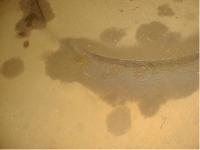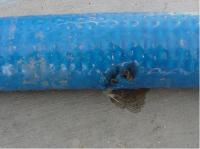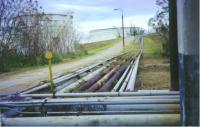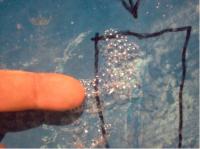Leak location may be important but commonly there may be little that one can usefully do with the information. The most commonly employed techniques include: acoustic or ultrasonic technology; trace element detection; helium gas mixtures detection; variable differential pressure testing.
Tank leak location
Tank tests are designed to challenge a tank system and deliberate steps are taken in test design to increase the tendency of the tank to lose fuel or to take on water without exceeding its design specification. However, a tank can be seriously holed without losing fuel (for example by being effectively sealed by clay surround) or a tank can take on water or lose fuel without being itself holed. The leak of a trace gas does not prove a liquid leak possibility. These factors create a challenge for those trying to locate leaks.
A tank leaking at 0.38 lt/h may have a single hole as small as 0.018 mm or several holes of a smaller diameter or, if porous, areas of submicroscopic holes. Small wonder that for over 60% of exhumed failed tanks, a hole cannot be found. The only clues that the tank had a problem may be the losses or gains that disappeared when the tank was replaced or repaired. Tank leak location might be highly desirable if there is action that can be taken to repair the flaw in situ or to prevent a recurrence of early failure in a particular design of tank or to establish responsibility. For tanks without man entry capability, the options are reduced and repair may not be economically possible. If the tank has served a useful working life and/or repair is not an option, leak location should probably be avoided.
MassTech International tank test technologies include inherent leak location features that can identify leak sites, below striker plates for example.
For above ground storage tanks, it is usually only the floor where leak location might be interesting. Consult us if this is the case.
Line leak location
Most of the foregoing applies equally to lines except that the desirability and practicality of leak location are probably greater. When steel lines fail through corrosion, replacement may be the best long-term option since the insertion of replacement sections can actually accelerate the process of future failure of the line. For fiberglass or polymeric lines this may not be the case. Fiberglass lines may be easily repaired without adversely impacting longevity. Polymeric lines are unlikely to fail along continuous sections unless suffering an event such as a natural disaster or invasion during maintenance work. Failures of polymeric lines are far more likely to lie with the terminations, end connections or the threads to which they attach. In most cases, all these should be designed to be visible with the removal of covers. Leak location is normally accomplished by emptying the line, applying a trace gas under pressure and following the lay on the line at the surface using a detector.
For pipelines, even testing can be difficult. Leak location might be possible. Consult us if this is the case.













